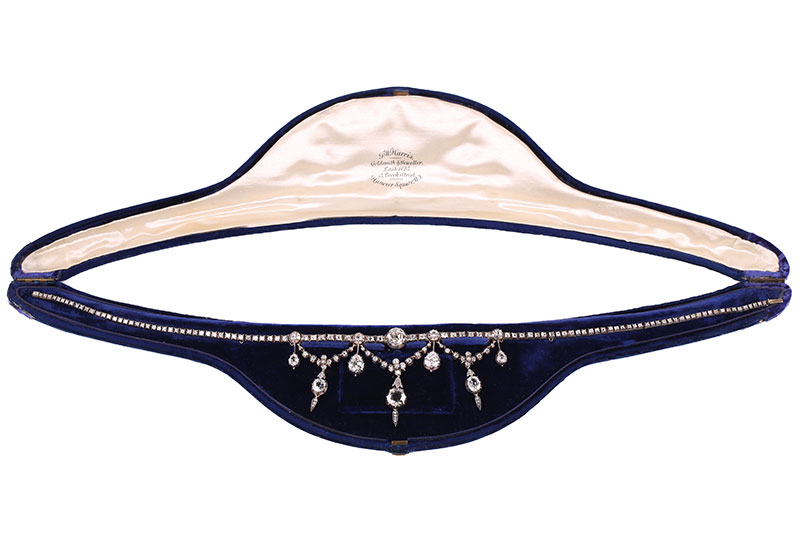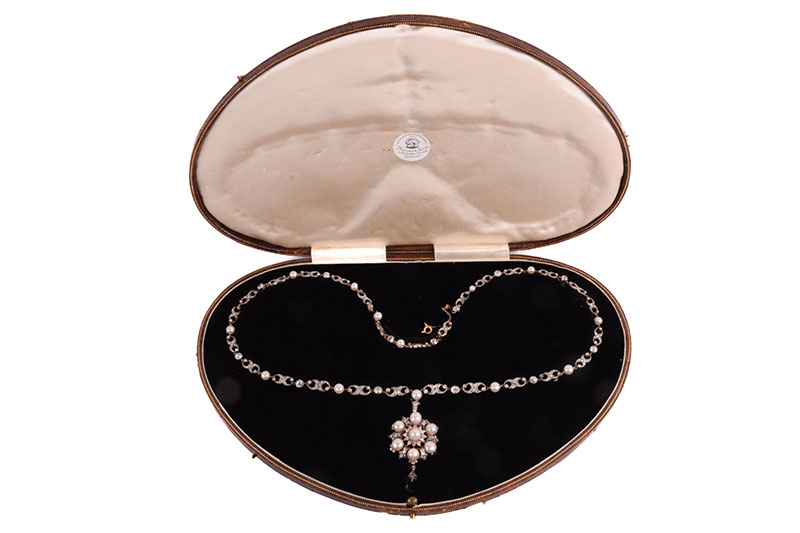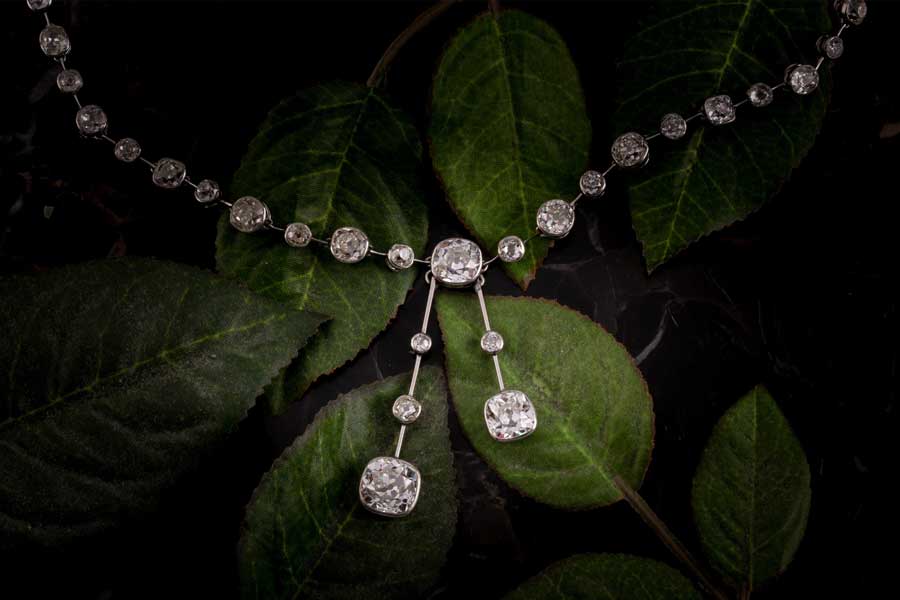How can you tell if a Necklace is Antique?
A step-by-step guide to help you identify Antique Necklaces
05/04/2024
The first necklaces are believed to have been created more than 120,000 years ago when stones and shells were thread onto string and worn around the neck. Since then, necklaces have evolved from this simple adornment to symbols of wealth, status, religion, and fashion. For an item of jewellery to be classified as antique, it will need to be at least 100 years old.
When it comes to determining age and confirming whether a necklace is antique, the style, construction and materials need to be carefully considered. Here we have put together a comprehensive guide to help determine if a necklace is, indeed, antique.
An important late Victorian diamond garland necklace
Throughout history the necklace has gone through many transitions, the overall appearance of a piece can offer significant guidance as to when it was made. Differentiated by lengths and design there are a variety of antique necklace styles to look out for.
- Lavalier: a chain that ends with a pendant and may feature further drops to the pendant; these were very popular in the early 20th A version of the lavalier, the negligee, emerged during the Edwardian era.
- Festoon or Garland: will be comprised of multiple strands, often highlighted with gem-set details.
- Sautoir: a long style necklace often extending past the waist, usually made with beads, pearls or chains, occasionally terminating with a tassel. Flapper necklaces were popular during the early 20th century and feature very similar characteristics.
- Choker: a necklace which would fit high and close on the neck, these were highly in demand from the 1700s, undergoing a revival during the Belle Epoque era (circa 1900).
- Rivière: a short necklace composed of a line of individually set faceted gemstones, often graduating in size. Early examples feature a closed back setting.
- Lockets: an openable compartment pendant attached to a chain – these were particularly popular throughout the 1800s.
- Bayadere or Rope: a braided necklace composed of several strings of beads or pearls, fashionable during the 1700s. A torsade necklace is very similar but will feature more strands.
- Bib: as the name suggests, a necklace that sits very close on the neck extending downwards to form a half-moon or triangle shape – often set with gems.
- Collier: this type of necklace sits flat and close to the neckline.
- Book chain: composed of small square or rectangular folded links, incredibly in demand during Victorian times.
- Lariat: a very long necklace that would wrap around the neckline, sometimes knotted or featuring a removable pendant slide-clasp.
- Fringe: a necklace designed to be worn at the base of the neck, featuring a series of suspended pendant drops, demand for this style surged around 1870.
An Early 20th-century pearl and diamond pendant necklace
Determining if the necklace has any stamps, hallmarks, engravings, or signatures will provide guidance about the date, origin, maker, and materials of the necklace. Centuries ago, it was not compulsory to assay gold and silver, so the absence of these marks is not uncommon with older pieces; indeed, even jewellery that was struck with marks may have been worn down and become illegible or completely erased over time.
Yellow gold and silver have been used in jewellery since 4400 BC and 5000 BC respectively, while the use of beads is even earlier. Platinum was first used to create jewelled accessories in the late 1800s, and white gold was only invented in the early 1900s.
The cut and type of any present gemstones can offer valuable insight into age, from rose-cut diamonds and table-cut garnets, to carved citrine and cabochon emeralds, it is important to identify the characteristics of each stone. The methods employed by lapidaries and their tools will provide clues about the origins of a piece.
The most archaic form of a clasp was developed as early as the Bronze and Iron ages, in the form of two bent-over wire ends. Prior to the 16th century, cords, hooks, and ribbons were predominantly utilised as clasps. A plaque of jewellery that features an open ring at each end, or D-shaped terminals, will most certainly have been made with the intention of using a ribbon fastening. During the Georgian era the tongue clasp emerged as the most popular clasp, jewellers would often fashion this clasp as part of the necklace design or pendant to the front of the neckpiece. In the 1840s the bolt ring clasp was developed, composed of a small ring with a hinged part which would push back into the circle and clip back into place; this evolved into the spring ring clasp which featured a lever to open the ring and a spring to close the lever shut. The slide tube clasp appeared from the mid-1800s, and the push-in box clasp was popular during Queen Victoria’s reign. Other clasps that predominantly appear in antique necklaces are the padlock, slide lock, as well as the barrel and tongue. Necklaces that were long enough to go over the head often didn’t have a clasp. It is worth noting that some antique jewellery may have replacement clasps, therefore this is only one aspect to consider.
An impressive antique collet-set diamond lavliere necklace
The presence of an original fitted box for the necklace can provide information about the maker or the retailer, as well as an address for the point of sale and therefore a timeline. A fitted case with no information can still assist with clues, the lining of the case, the outer binds, etc, all offer little clues as to the bigger picture.
Antique jewellery will almost certainly have some wear, from very slight through to incredibly tired, the wear tells the story of how a necklace was loved and adorned over its existence. Clasps are the most common culprit when it comes to wear and tear, so as mentioned earlier, pay close attention for possible replacement. Examine the links for any damage or repairs, look out for dark grey sections of melted metal which would indicate lead solder, unfortunately very popular for repairs from the 1850s – the lead eats away at the metal underneath and ultimately significantly devalues a piece. If any stones are missing or damaged, use a magnifying glass or loupe to study the setting, foil-back settings were prevalent during the 19th century.
Related Articles
How Can Tell if Jewellery is Victorian?
Is Antique Jewellery Worth Anything?
Where is the Best Place to Sell Antique Jewellery?
Do you have any antique jewellery that you are considering selling?
With a global audience of over 10 million, Dawsons can achieve the best price for you at auction.
Get in touch with a jewellery expert for confidential sales advice today, we would be delighted to help:


